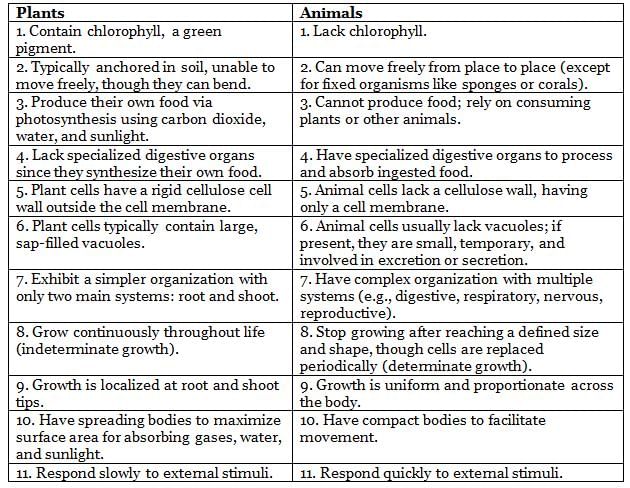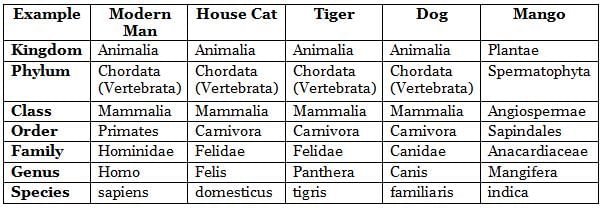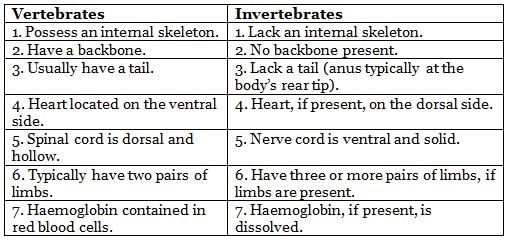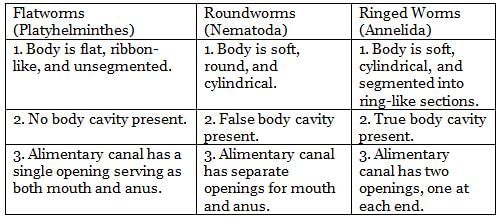Five Kingdom Classification Chapter Notes | Biology Class 9 ICSE PDF Download
Introduction
The Five Kingdom Classification is a system used to categorize the vast diversity of living organisms based on their characteristics and complexity. From simple single-celled bacteria to complex multicellular animals like elephants, this classification helps us understand the relationships and differences among organisms. By grouping them into kingdoms, phyla, classes, and other categories, we can study their structure, behavior, and evolutionary connections. This chapter explores the five kingdoms—Monera, Protista, Fungi, Plantae, and Animalia—along with their characteristics, examples, and the hierarchical classification system from species to kingdom.
What is Species?
- Species is a group of organisms that can interbreed to produce fertile offspring.
- All members of a species share similar characteristics but may vary in traits like color or size.
- Example: House cats (Felis domesticus) belong to one species as they can interbreed, despite differences in appearance.
- All humans belong to the species Homo sapiens, capable of interbreeding despite physical differences.
- Peepal trees and mango trees each belong to their respective species.
- Crosses between different species, like a horse and donkey, produce sterile hybrids (e.g., mule or hinny).
- A mule is a hybrid of a male donkey and a female horse, resembling both but unable to reproduce.
- A hinny, a cross between a male horse and a female donkey, is also sterile.
Examples of Crosses Between Different Species
- Zebra and donkey produce a sterile "zenkey" with donkey-like ears and zebra-like striped legs.
- Tiger and female lion produce a sterile "tigon."
- Goat and sheep produce a sterile "geep."
- Pomato, a cross between potato and tomato, produces potatoes underground and tomatoes above ground but no seeds.
- Hybrids from closely related species are sterile and cannot reproduce.
Categories Higher Than Species
- Genus: A group of similar species. Example: House crow (Corvus splendens) and jungle crow (Corvus macrorhynchos) belong to the genus Corvus.
- Family: A group of related genera. Example: The cat family Felidae includes genera Panthera (lion, tiger) and Felis (domestic cat).
- Order: A group of related families. Example: The order Carnivora includes the cat family (Felidae) and dog family (Canidae).
- Class: A group of related orders. Example: The class Mammalia includes orders like Carnivora, Primates, and others with hairy skin and milk glands.
- Phylum: A group of related classes. Example: The phylum Chordata includes classes like mammals, birds, reptiles, and fishes with a notochord or backbone.
- Kingdom: The largest division of living beings, grouping related phyla.
Drawbacks of the Old Two Kingdom Classification
- The old system by Linnaeus divided organisms into only two kingdoms: Plantae and Animalia.
- Bacteria and fungi were classified as plants, despite lacking chlorophyll and photosynthesis.
- Single-celled organisms like Euglena have both plant-like (chloroplasts) and animal-like (cell mouth, contractile vacuole) traits, making classification difficult.
- Bread mould, a multicellular organism, lacks roots, stems, leaves, flowers, or chlorophyll, not fitting well as a plant.
Five Kingdom Classification
The modern classification divides organisms into five kingdoms: Monera, Protista, Fungi, Plantae, and Animalia.
Kingdom Monera
- Consists of unicellular, prokaryotic organisms (no organized nucleus).
- Nuclear material (DNA) is not enclosed in a nuclear membrane.
- Lacks membrane-bound organelles like mitochondria or chloroplasts.
- Includes bacteria, blue-green bacteria, and some unicellular algae.
- Bacteria have three common shapes: rods, spirals, and spheres (singly, in groups, or chains).
- Examples: Bacteria.
Kingdom Protista (Protoctista)
- Consists of unicellular, eukaryotic organisms (with a well-defined nucleus).
- Includes both autotrophic (green, e.g., Chlamydomonas) and heterotrophic (non-green, e.g., Euglena, Amoeba, Paramecium) organisms.
- Some multicellular photosynthetic descendants, like Pandorina, are included.
- Examples: Chlamydomonas, Euglena, Amoeba, Paramecium.
Kingdom Fungi
- Multicellular, eukaryotic, saprophytic organisms (feed on dead organic matter).
- Made of thread-like hyphae with many nuclei in continuous cytoplasm.
- Lack chlorophyll and do not perform photosynthesis.
- Examples: Bread mould, Toadstool, Yeast, Penicillium.
Kingdom Plantae
- Multicellular, eukaryotic, autotrophic organisms (make food via photosynthesis).
- Contain chlorophyll and have a cell wall made of cellulose.
- Divided into five major groups: Thallophyta, Bryophyta, Pteridophyta, Gymnosperms, and Angiosperms.
Thallophyta:
- Includes all algae, which are primarily aquatic.
- Have a thallus-like body (no distinct roots, stem, or leaves).
- Autotrophic due to chlorophyll.
- Examples: Chlamydomonas, Volvox.
Bryophyta:
- Includes mosses and liverworts with a plant body having false root-like structures (rhizoids) and leaf-like structures.
- Autotrophic plants.
- Examples: Mosses, Liverworts.
Pteridophyta:
- Includes ferns with a plant body differentiated into roots, stem, and leaves.
- Leaves often have leaflets bearing spores on the underside.
- Non-flowering plants.
- Examples: Ferns.
Gymnosperms:
- Includes plants like cycas, pine, and fir with naked seeds (not enclosed in fruits).
- Can be trees or shrubs, bearing both male and female flowers.
- Divided into cycads and conifers.
- Examples: Cycas, Pine, Fir.
Angiosperms:
- This group encompasses all flowering plants, characterized by a well-developed plant structure divided into roots, stems, leaves, flowers, and fruits.
- Their seeds are enclosed within fruits.
- Angiosperms are categorized into two subgroups: monocots and dicots.
Monocots:
- These plants produce seeds with a single cotyledon, feature leaves with parallel venation, and have a fibrous root system.
- Examples include maize, rice, and grass.
Dicots:
- Plants in this group produce seeds with two cotyledons, have leaves with reticulate venation, and possess a taproot system.
- Examples include pea, potato, apple, sunflower, and rose.
Kingdom Animalia
- Multicellular, eukaryotic, heterotrophic organisms (obtain food by eating).
- Lack cell walls and chlorophyll, usually mobile.
- Divided into invertebrates (no backbone) and vertebrates (with backbone).
Naming an Organism
Common Names and Their Variability
- Common names for plants and animals can be confusing because they vary across regions. In India, for instance, a single plant or animal may have multiple names depending on the local language.
- Take the pumpkin, known as “sitaphal,” “kashiphal,” “kumhra,” “petha,” or “kaddu” in different areas. Similarly, the custard apple has various regional names.
- However, common names often fail to specify a particular species. For example, terms like “frogs,” “earthworms,” or “grasses” are too broad, as they encompass multiple species. Similarly, distinguishing between types of crows requires adjectives like “hill crow” or “house crow.”
- Yet, these names can be misleading, as a hill crow may visit plains, and a house crow may be found in hills. Crucially, these crows belong to different species because they cannot interbreed.
Scientific Names and Binomial Nomenclature
- To avoid confusion caused by local names, scientists use a standardized naming system called binomial nomenclature, introduced by Linnaeus (1707–1778).
- This system assigns each species a two-part name: the first part indicates the genus, and the second specifies the species within that genus. For example, the hill crow is Corvus macrorhynchos, and the house crow is Corvus splendens.
- Both share the genus Corvus but differ in species. This method ensures clarity and consistency across global scientific research.
General Differences Between Plants (Plantae) and Animals (Animalia)

A Sample Classification Of Living Being's
Sample Classification of Living Beings
Living organisms are classified hierarchically, from the broadest category, Kingdom, to the most specific, Species. Below is an example of classification for several organisms:

Rules for Writing Scientific Names
- Scientific names are written in Roman script and italicized when printed. When handwritten, they must be underlined.
- The genus name begins with a capital letter, while the species name starts with a lowercase letter.
Scientific Names of Common Organisms
Animals
- Modern Man: Homo sapiens
- House Cat: Felis domesticus
- Dog: Canis familiaris
- Honeybee: Apis indica
- Housefly: Musca domestica
- Peacock: Pavo cristatus
- Cobra: Naja naja
- Hoopoe: Upupa epops
Plants
- Peepal: Ficus religiosa
- Mango: Mangifera indica
- Potato: Solanum tuberosum
- China Rose: Hibiscus rosa-sinensis
- Okra (Bhindi): Hibiscus esculentus
- Pineapple: Ananas comosus
- Pigeon Pea (Arhar): Cajanus cajan
- Lentil (Masur): Lens esculenta
Diversity in Animals
You have learned that animals (Kingdom Animalia) differ significantly from plants (Kingdom Plantae). To date, over 1,000,000 animal species have been identified, with new species discovered annually. These animals are systematically classified into various groups and subgroups based on their characteristics.
Major Groups of Animals
- The animal kingdom is divided into nine major phyla.
- Porifera, Cnidaria, Platyhelminthes, Nematoda, Annelida, Arthropoda, Mollusca, Echinodermata, Chordata.
Invertebrata and Vertebrata
The phyla from Porifera to Echinodermata are classified as Invertebrates, meaning animals without a backbone. In contrast, the phylum Chordata includes animals with a backbone, commonly known as Vertebrates. This distinction between Invertebrata (no backbone) and Vertebrata (with backbone) is a practical classification, not a formal taxonomic one. Table 8.2 outlines the key differences between these groups.
Key Differences Between Vertebrates and Invertebrates

Invertebrate Phyla - Porifera to Echinodermata
1. Phylum Porifera (Pore-bearers, Sponges)
- Simplest multicellular animals with a hollow tube-like body.
- Have many pores for water entry and a large opening for water exit.
- Capture food from water passing through pores.
- Usually have a skeleton of microscopic spicules or elastic spongin fibers.
- Mostly marine, except a few freshwater sponges.
- Examples: Sycon, Bath sponge.
2. Phylum Cnidaria (Coelenterata, Sac-like Animals)
- Have a two-layered body wall enclosing a single cavity for digestion.
- Have a single mouth surrounded by tentacles to catch food.
- Mostly marine, a few in freshwater.
- Corals develop hard calcium carbonate skeletons (not bones).
- Examples: Hydra, Jellyfish, Sea anemone, Corals.
3. Phylum Platyhelminthes (Flatworms)
- Small, soft, flattened, unsegmented worms without a body cavity.
- Alimentary canal has one opening (mouth).
- Most are parasitic, some are free-living in sea or freshwater.
- Examples: Liverfluke, Tapeworm (parasitic); Planarian (free-living).
4.Phylum Nematoda (Roundworms)
- Long, cylindrical, unsegmented worms without a true body cavity.
- Alimentary canal has two openings (mouth and anus).
- Mostly parasitic, some free-living in soil.
- Examples: Hookworm, Ascaris, Eelworms.
5. Phylum Annelida (Segmented or Ringed Worms)
- Cylindrical body divided into ring-like segments.
- Have a true body cavity (coelom) and a digestive system with mouth and anus.
- Examples: Earthworm, Leech, Nereis.
Earthworm Characteristics:
- Live in burrows in damp soil, eating through soil to make burrows.
- Soil consumed contains organic matter (humus, leaf bits) and is passed as castings.
- Nocturnal, avoiding light, and crawl at night for feeding and mating.
- Require moist skin for respiration; dry soil is unsuitable.
- Indian earthworm (Pheretima posthuma) has 80-100 segments, no head, eyes, or legs.
- Mouth at the front, anus at the hind end, with a clitellum (glandular band) for reproduction.
Economic Importance of Earthworms:
- Loosen and aerate soil, aiding plant root respiration and growth.
- Interchange topsoil with lower layers, enhancing soil fertility.
- Excreta rich in nitrogen, beneficial for plants.
- Used in vermiculture for high-quality manure production.
- Used as fishing bait.
6. Phylum Arthropoda (Jointed-legged Animals)
- Largest phylum with the most species in the animal kingdom.
- Have jointed limbs, one pair per segment or on all segments.
- Have a chitinous exoskeleton, which is shed and regrown during moulting.
Divided into four classes: Crustacea, Myriapoda, Insecta, Arachnida.
- Class Crustacea: Aquatic, with fused head and thorax, many appendages. Examples: Crayfish, Crabs.
- Class Myriapoda: Many segments, each with one or two pairs of limbs. Examples: Centipede, Millipede.
- Class Insecta: Body divided into head, thorax, abdomen; three pairs of legs; usually two pairs of wings. Examples: Housefly, Mosquito, Beetle, Grasshopper.
- Class Arachnida: Fused head and thorax, four pairs of legs, no wings or antennae. Examples: Spiders, Scorpions, Mites, Ticks.
- Examples: Crayfish, Crabs, Millipede, Centipede, Insects, Scorpions, Spiders.
Differences Among Flatworms, Roundworms, and Ringed Worms

Body Symmetry
- Asymmetrical: No equal halves when cut (e.g., Amoeba).
- Radially Symmetrical: Equal halves along any radius through the center (e.g., Starfish).
- Bilaterally Symmetrical: Equal halves only along the middle axis (e.g., Housefly, Human).
Body Directions
- Anterior: Towards the front.
- Posterior: Towards the hind end.
- Dorsal: Upper side or back of the body.
- Ventral: Lower or underside of the body.
- Lateral: Sides (right or left).
7. Phylum Mollusca
- Soft, unsegmented body with a hard, calcareous shell for protection.
- Have a muscular foot for locomotion or as a weapon.
- Examples: Snail, Slug, Oyster, Mussel, Clam, Squid, Octopus.
8. Phylum Echinodermata (Spiny-skinned Animals)
- Unsegmented, marine animals with a spiny exoskeleton.
- Move using tube-feet and are radially symmetrical (five parts around a central point).
- Examples: Starfish, Brittle-star, Sea-urchin, Sea-cucumber.
Phylum Chordata (Vertebrata)
All chordates possess a notochord, a rod-like structure along the mid-dorsal axis of the body. In most chordates, except for some primitive species where the notochord persists throughout life, it is replaced by a vertebral column (backbone) during development. All vertebrates, including humans, have a notochord during embryonic stages.
Vertebrates, a subgroup of chordates, are characterized by a well-developed vertebral column that forms the primary axis of their internal skeleton, which may consist of bone or cartilage. They typically have a head, trunk, and two pairs of appendages, with gill slits present at some stage of life. Vertebrates are classified into five groups: fishes, amphibians (e.g., frogs), reptiles (e.g., lizards), birds, and mammals (hairy quadrupeds).
Classification of the Animal Kingdom
The animal kingdom is divided into Invertebrates (animals without a backbone) and Vertebrates (animals with a backbone).
- Invertebrates: Have a ventral nerve cord, heart (if present) on the dorsal side, and hemoglobin (if present) dissolved in blood.
- Vertebrates (Phylum Chordata): Possess a notochord or vertebral column, a dorsal nerve cord, a ventral heart, and hemoglobin contained in red blood cells.
Invertebrate Phyla:
- Phylum Porifera: Pore-bearing, aquatic, fixed animals with spongy fibers for protection (e.g., sponges, Sycon). Organized at the cellular level.
- Phylum Cnidaria: Two-layered body wall (epidermis and gastrodermis), radially symmetrical, with tentacles and stinging cells, bisexual (e.g., Hydra, corals). Organized at the tissue level.
- Phylum Platyhelminthes: Flat, unsegmented worms with bilateral symmetry, no body cavity (acoelomate), bisexual, single opening for mouth and anus, free-living or parasitic (e.g., Planaria—free-living; liver fluke, tapeworm—parasitic). Organized at the organ and organ system level.
- Phylum Nematoda: Soft, cylindrical, unsegmented worms with a false body cavity, two openings (mouth and anus), parasitic (e.g., Ascaris, eelworm, filaria worm). Organized at the organ and organ system level.
- Phylum Annelida: Soft, segmented worms with a true body cavity, two openings, bisexual, excrete through nephridia (e.g., earthworm, leech). Organized at the organ and organ system level with a true coelom.
- Phylum Arthropoda: Body divided into head, thorax, and abdomen, with an exoskeleton that molts, jointed legs (e.g., insects, crabs). Organized at the organ and organ system level with a true coelom.
- Phylum Mollusca: Aquatic animals with a soft body protected by a hard shell, breathe through gills, move using a muscular foot (e.g., oysters, slugs, clams). Organized at the organ and organ system level with a true coelom.
- Phylum Echinodermata: Marine, radially symmetrical, spiny-skinned animals without a head, with five arms and tube feet for locomotion (e.g., starfish, brittle star). Organized at the organ and organ system level with a true coelom.
Vertebrate Classes
Class Pisces (Fishes)
- Fully aquatic, cold-blooded (poikilothermal).
- Have a two-chambered heart, breathe with gills, and have scaly skin.
- Use fins for locomotion, no limbs.
- Two types: Cartilaginous (skeleton of cartilage, e.g., Sharks, Dogfish) and Bony (skeleton of bones, e.g., Carps, Trouts).
- Bony fishes have gill-covers; cartilaginous fishes have exposed gill slits.
Class Amphibia
- Live on land and in water, cold-blooded.
- Larvae breathe with gills; adults use lungs and have moist, non-scaly skin.
- Have a three-chambered heart and pentadactyl (five-fingered) limbs.
- Eardrum on the skin surface, external fertilization.
- Examples: Frog, Toad, Salamander, Newt.
Class Reptilia
- Fully adapted to land, cold-blooded.
- Have rough, horny scales, breathe with lungs, and lay leathery eggs.
- Three-chambered heart (partially divided ventricle).
- Eardrum in a tubular depression.
- Examples: Lizard, Snake, Tortoise, Turtle, Crocodile, Alligator, Gharial.
Class Aves
- Birds, warm-blooded (homeothermal), with a constant body temperature.
- Have feathers, scaly legs, and forelimbs modified into wings.
- Four-chambered heart, breathe with lungs, lay calcareous eggs.
- Streamlined body and light skeleton for flying.
- Examples: Pigeon, Sparrow, Crow, Duck, Owl, Penguin, Ostrich, Emu.
Bird Facts:
- Cuckoo: Male sings, female lays eggs in crow’s nest.
- Hawk cuckoo: Lays eggs in seven-sisters’ nest.
- Swan: Cannot separate milk from water or eat pearls.
- Chakor: Loves moonlight but does not fly into the moon or eat charcoal.
Class Mammalia
- Mammals are highly adapted for terrestrial life, though some, like whales and porpoises, inhabit water, and bats are capable of flight.
- Most mammals are viviparous, giving birth to live young, except for the Australian spiny anteater and duckbilled platypus, which are egg-laying. Mammals nurse their young with milk from mammary glands and have hair on their skin.
- They are warm-blooded, possess a muscular diaphragm separating the thorax and abdomen, and have a four-chambered heart, breathing through lungs. Typically, they have external ears (pinnae) and external testes housed in a scrotum.
Summary of Vertebrate Classification
Classes of Vertebrates:
- Pisces (Fishes): Cold-blooded, aquatic animals with slimy, scaly skin. They breathe through gills, have a two-chambered heart, reproduce via external fertilization, and move using fins.
- Cartilaginous Fish: Skeleton made of cartilage (e.g., shark, dogfish).
- Bony Fish: Skeleton made of bone (e.g., trout, rohu).
- Amphibia: Cold-blooded animals that live both in water and on land, with slimy skin. They respire through gills, skin, and lungs, have two pairs of limbs, a three-chambered heart, and external fertilization (e.g., frog, salamander).
- Reptilia: Cold-blooded, terrestrial animals with dry, scaly skin. They breathe through lungs, have two pairs of limbs, a three-chambered heart, and lay leathery eggs (e.g., snake, lizard).
- Aves (Birds): Warm-blooded, aerial animals with forelimbs modified as wings and feathered skin. They breathe through lungs, have a four-chambered heart, and lay calcareous eggs (e.g., parrot, crow, duck).
- Mammalia: Warm-blooded animals adapted to various habitats, with hairy skin and lungs for breathing. They have two pairs of limbs, a four-chambered heart, give birth to live young (viviparous), and produce milk via mammary glands. They typically have external ears (pinnae) (e.g., whale, dolphin, bat, dog, cat, humans).
Points to Remember
- Linnaeus introduced binomial nomenclature for naming organisms (genus + species).
- Species is the lowest classification level, where organisms can interbreed.
- Higher ranks: Genus, Family, Order, Class, Phylum, Kingdom.
- Five kingdoms: Monera (prokaryotic, unicellular), Protista (eukaryotic, unicellular), Fungi (eukaryotic, saprophytic), Plantae (eukaryotic, autotrophic), Animalia (eukaryotic, heterotrophic).
- Animals are divided into vertebrates (with backbone) and invertebrates (without backbone).
- Protozoa are single-celled eukaryotic Protista.
- Sponges (Porifera) are fixed aquatic animals with pores for water flow.
- Cnidarians have a two-layered body with tentacles around the mouth.
- Platyhelminthes have a flat body with one gut opening.
- Nematoda are roundworms with two gut openings.
- Annelids have a segmented body without limbs.
- Arthropoda have a segmented body with jointed appendages, divided into Crustacea, Myriapoda, Insecta, and Arachnida.
- Mollusca have a soft body, usually with a shell.
- Echinodermata are radially symmetrical with a spiny exoskeleton.
- Vertebrates include five classes: Pisces, Amphibia, Reptilia, Aves, Mammalia.
|
18 videos|101 docs|19 tests
|
FAQs on Five Kingdom Classification Chapter Notes - Biology Class 9 ICSE
| 1. What is the definition of a species in biological terms? |  |
| 2. What are the major categories higher than species in biological classification? |  |
| 3. What are the drawbacks of the old two-kingdom classification system? |  |
| 4. How does the five-kingdom classification system differ from the two-kingdom system? |  |
| 5. What are the main characteristics that differentiate invertebrates from vertebrates? |  |
















